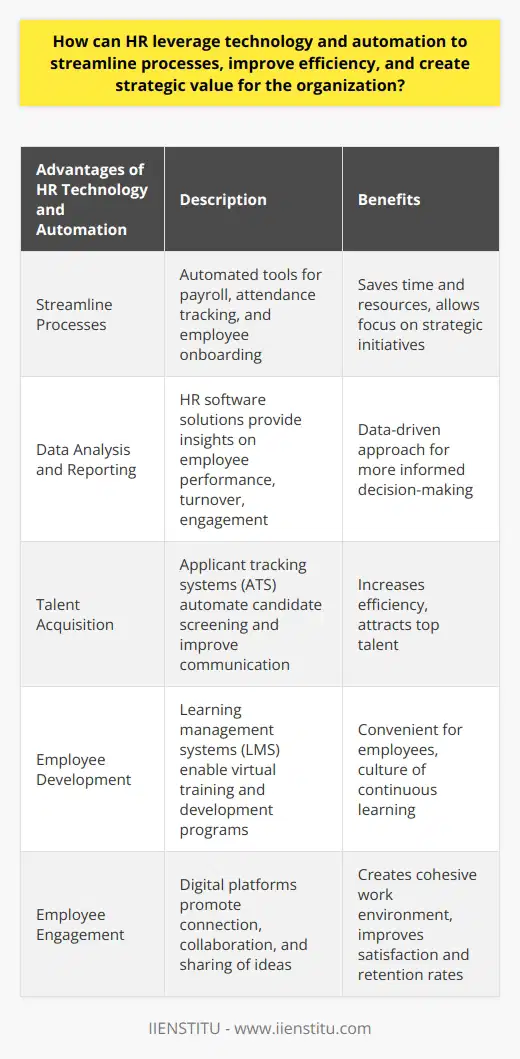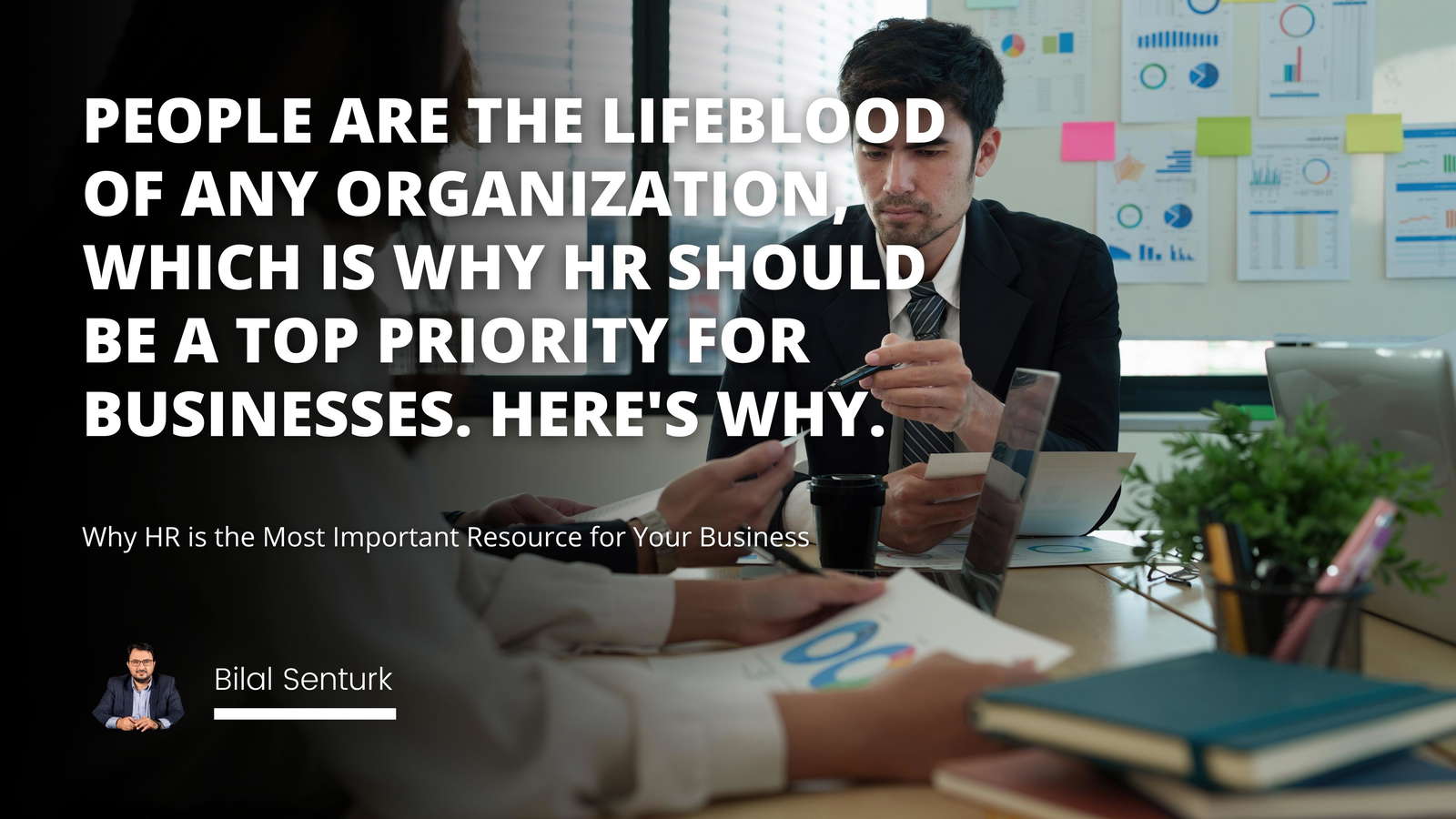
HR’s Growing Role in Strategic Growth and Value
Identifying Inefficiencies & Ways to Enhance Productivity
Leveraging HR in Strategic Decision Making
With organizations needing to ensure that their businesses remain competitive, the role of human resources (HR) has grown significantly. There’s no doubt that HR has an increasingly vital role to play in strategic growth and value. From identifying areas of inefficiency to leveraging HR data and technology in core business operations, today’s business leaders need to ensure that HR is up to the challenge.
HR’s Growing Role in Strategic Growth and Value
Gone is when HR was viewed merely as a function to process paperwork and hire and terminate staff. As the demands of businesses have increased, so too have the orders placed on the HR department. To maximize corporate value, HR professionals must be able to proactively identify opportunities to capitalize on current trends and anticipate potential labor market and technological opportunities while also finding ways to eliminate inefficiencies and improve productivity.
Organizations must be aware of current trends and able to adapt existing processes through HR initiatives. For instance, by bridging the gap between employee development, recruitment, and retention, HR can identify focus areas and proactively use employee skills and knowledge. In addition, HR should have a clear understanding of the strategic direction the organization wishes to take and be able to identify ways to create value.
Identifying Inefficiencies & Ways to Enhance Productivity
Today’s business environment is complex and ever-changing, with constant pressure to innovate and increase productivity. This often leaves organizations with the tough decision of identifying the most efficient processes while remaining flexible enough to adjust. This is why understanding the business is essential for HR professionals. Doing so enables them to identify inefficiencies and potential ill-suited processes or personnel. An effective HR strategy means understanding the problems and finding ways to address the organization’s needs.
HR can increase productivity by ensuring that tasks are appropriately delegated, and individuals are assigned the optimal workload. This results in adequate utilization of resources and better job satisfaction, which can boost morale and result in higher engagement. Additionally, developing clear goals and objectives and providing employees with the necessary support and resources can help improve concentration and productivity.
Leveraging HR in Strategic Decision Making
Organizations must be agile and proactive in unpredictable circumstances and economic shifts. To face such challenges, the HR department must be part of the strategic decision-making process, working with senior leadership teams to analyze current conditions and anticipate potential obstacles or opportunities.
Related Course: Leadership Course Online
HR should also look at ways to use digital tools to improve decision-making, educate business leaders on changes in the workforce and establish ways to leverage HR data to inform strategic decisions. Furthermore, HR must be prepared to handle any pertinent legal matters, ensuring the organization complies with regulatory or legal guidelines specific to its industry.
Conclusion: There’s no doubt that HR has an essential role to play in strategic growth and value. By understanding their function and the organization’s goals, HR professionals can help identify weaknesses, inefficiencies, and opportunities while using data and technology to inform decision-making. In today’s world, staying competitive requires agility and adapting to an ever-changing business landscape. HR teams must rise to the challenge.
Strategic growth and value start with unlocking HRs creativity and potential.
In conclusion, the role of HR has evolved to become an essential component of a business's strategic growth and value. To foster this growth and create value, HR professionals need to focus on identifying inefficiencies, enhancing productivity, and taking an active role in strategic decision making. Using their keen understanding of the organization's goals, they can both recognize and leverage opportunities as well as anticipate potential challenges. They also need to utilize data and digital tools effectively to inform their decisions and maintain competitiveness. Legal compliance is also a critical aspect of their role. For those interested in improving and keeping pace with these shifting demands, exploring the best HR certification courses online is a worthwhile investment.

Frequently Asked Questions
How can HR assist in creating and implementing corporate strategies to drive organizational growth?
Employee engagement is an increasingly important component of organizational growth, where Human Resources (HR) departments play a significant role. A well-resourced HR team is essential for helping organizations create, implement and track corporate strategies designed to foster open communication, shared knowledge, and team-building behaviors that support successful teamwork and collaboration.
Organization's successful corporate strategies to drive organizational growth must include seeing qualitative and quantitative data from all aspects of an organization’s operations. In addition, human Resources departments should act as the bridge between management and employees, ensuring that the company’s core values are communicated, appropriate metrics are in place for measuring progress, and a corporate culture is established that encourages innovation and hard work.
Human Resources can also play an essential role in designing and implementing company-wide training that provides employees with the skills they need to stay ahead of the curve in their respective roles. Additionally, HR can work to develop a system that benefits everyone involved by promoting employee development and career progression. Finally, a system needs to be created where employee feedback is actively sought, valued, and acted upon. An essential part of the HR team'scompany's task is to provide input on potential corporate strategies, serving as the voice of the employees and providing a direct link between the employees and the organization's successes.
Companies that can generate and sustain organizational growth in today's business environment will have a greater chance of long-term success. With the help of an effective HR team, companies can optimize human resources and create corporate strategies that drive measurable value for the organization. In addition, by taking a comprehensive approach to employee engagement and actively involving HR in developing corporate strategy, companies can foster open communication, knowledge sharing, and creative thinking, allowing them to stay ahead of the curve and drive organizational growth in the long run.
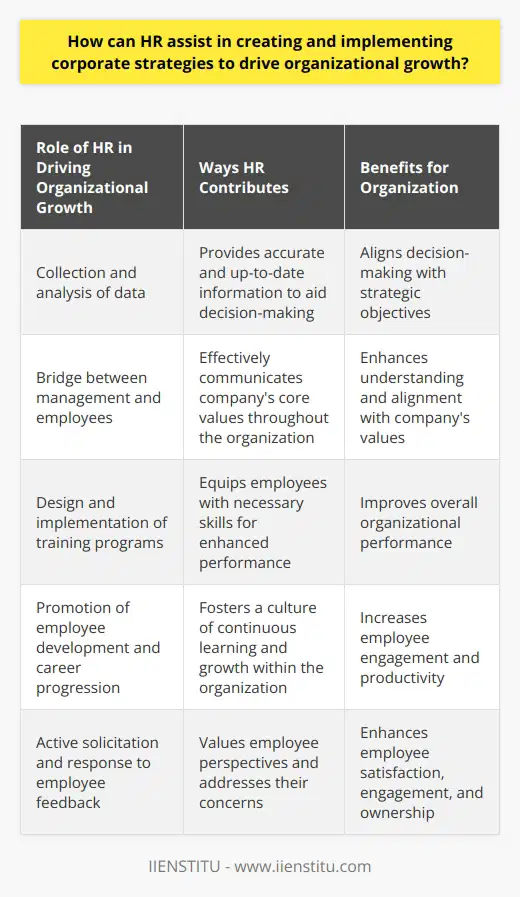
What role does HR play in connecting business goals to people-related strategies for achieving organizational success?
Human resources (HR) plays a pivotal role in connecting business goals to strategies for achieving organizational success by leveraging the power and potential of its people. HR activities, such as recruitment, training, compensation, discipline, and onboarding, enable organizations to develop and maintain a strong talent pool. This, in turn, gives organizations the capability to reach their goals.
When setting objectives, HR must understand the strategic goals and objectives of the organization. This is important so the HR team can proactively create and implement plans that support these goals by leveraging the most suitable people-related strategies. For example, if the organization aims to increase profitability by reducing costs, HR can develop strategies that support this goal. Such systems may include recruiting and hiring cost-conscious talent, offering incentives to employees to find new and more efficient working methods, or cutting training budgets.
HR can also create strategies specifically designed to create a motivating and inspiring work environment for employees. This strategy may include offering perks and benefits tailored to individual needs, ensuring recognition of employees' contributions to organizational success, or implementing flexible working hours and schedules. Such initiatives can positively affect employee performance, morale, and satisfaction, as well as lead to higher retention rates.
Finally, HR can facilitate the development of mutually beneficial long-term relationships with the employee by ensuring good communication between employees and management. This allows for an improved understanding of the objectives and expectations of both sides and establishes a basis for mutual trust and respect.
In conclusion, HR plays a vital role in connecting business goals to people-related strategies, which helps to promote organizational success. By understanding the organization's goals and proactively creating plans tailored to these objectives, HR can ensure that the organization remains competitive and successful.

How can HR provide data insights to prove the value of HR initiatives to the senior leadership team?
As HR professionals, providing meaningful data insights that demonstrate the value of HR initiatives to the senior leadership team is becoming increasingly important. In addition, with business leaders becoming increasingly numbers-focused, the successful implementation of HR initiatives must be tied to data-driven results. In this blog post, I will explore some of the ways in which HR teams can use data to prove the success of their initiatives to the senior leadership team.
The first step to providing data-driven insights is to identify the tracking metrics that will be used to measure the success of the HR initiative. Having clearly defined objectives and metrics to measure success is essential to ensure that the data collected can clearly demonstrate the returns on the effort and expense.
The next step is to collect and analyze the data. The data gathered should be quantitative and qualitative and can be sourced from employee surveys, performance reviews, and customer feedback. Depending on the goal of the HR initiatives and the specific data gathered, the analysis should be designed to show how the initiatives have improved employee engagement, productivity, retention rates, etc.
Once the data has been gathered and analyzed, HR teams can present the insights to the senior leadership team. Therefore, ensuring the data is presented in an easily digestible and understandable format is essential. Additionally, the presentation should highlight real-life successes to clearly show what is being achieved and where the value lies.
Finally, it is essential that the HR team actively follows up on the initiatives and keeps the senior leadership team informed of any developments or changes. This ongoing dialogue ensures that the data presented is up to date and shows the team that HR is constantly monitoring and responding to the impact of their initiatives.
In conclusion, HR teams can provide data insights to prove the value of HR initiatives to the senior leadership team. When creating and implementing HR initiatives, it is essential to ensure that the goals are clearly defined and that the data collected and analyzed is meaningful. Additionally, HR teams should ensure that the data is presented in an easily digestible form and that there is an active dialogue about the impact of the initiatives. This data-driven approach of presenting the evidence of HR initiative successes will help the senior leadership team to understand the value of the HR initiatives and ensure that the efforts and investments are justified.

What is the significance of aligning HR policies and practices with an organization's strategic objectives?
The Importance of HR Policy Alignment
The alignment of human resource (HR) policies and practices with an organization's strategic objectives holds considerable significance in the contemporary business environment. This alignment facilitates the development of a strong and competitive organization by ensuring that the human capital is effectively managed in alignment with the organization's goals and priorities. This academic paragraph explores how the alignment of HR policies and practices contributes to organizational success by enhancing employee engagement, promoting organizational culture, and establishing clear expectations for employees.
Enhancing employee engagement
A critical aspect of aligning HR policies and practices with strategic objectives is fostering the engagement of employees in the organization's overall goals. When HR policies are designed to support employee development and growth, individuals are more likely to feel valued, motivated, and committed to the company's success. In this way, the alignment of HR policies and practices not only improves employee satisfaction but also drives workforce performance, ultimately contributing to the achievement of the organization's strategic objectives.
Promoting organizational culture
In addition to its impact on employee engagement, the alignment of HR policies and practices with an organization's strategic objectives also plays a vital role in promoting a robust organizational culture. By creating HR policies that reflect the organization's values and goals, employees are better equipped to understand and embrace the company's mission and purpose. This strong alignment allows for the development of a cohesive and collaborative work environment, which in turn fosters employee commitment, loyalty, and overall productivity.
Establishing clear expectations
Lastly, aligning HR policies and practices with an organization's strategic objectives helps to establish clear expectations for employees. When HR policies are crafted in harmony with the organization's long-term goals, employees gain a clear understanding of what is expected of them and are more likely to align their individual performance with organizational objectives. This clarity enables a stronger performance management system, as employees readily recognize the connection between their roles and the organization's success.
In conclusion, the alignment of HR policies and practices with an organization's strategic objectives is of utmost significance in the contemporary business environment. This alignment fosters employee engagement, promotes a strong organizational culture, and establishes clear expectations for employees, all of which are instrumental in driving organizational success. Companies that prioritize such alignment are more likely to cultivate a high-performing workforce, ultimately contributing to their competitive advantage in the market.
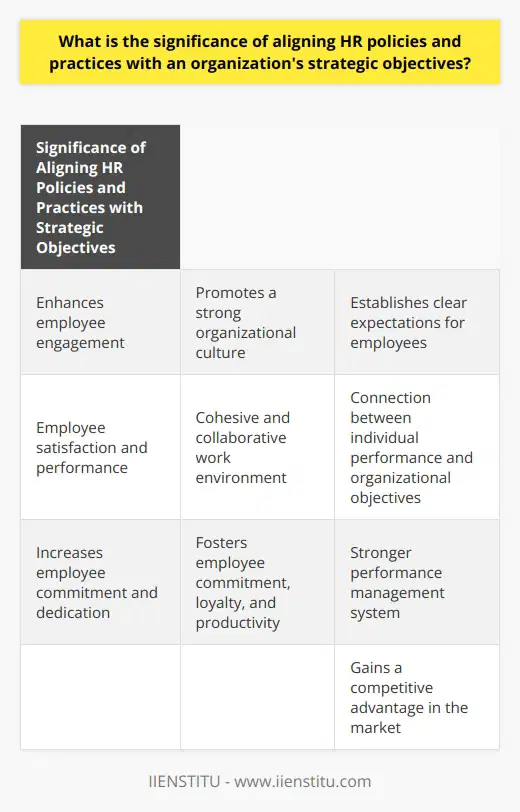
Can you explain the relationship between HR strategic planning and overall business operational planning?
The Link Between HR Strategic Planning and Business Operational Planning
To understand the relationship between human resources (HR) strategic planning and overall business operational planning, it is essential to first define the key components of these two concepts. HR strategic planning encompasses an organization's process of identifying, developing, and implementing the necessary human capital initiatives to support business goals. Operational planning, on the other hand, refers to the day-to-day, short-term management and decision-making process that aligns resources to achieve set objectives.
Integration of HR and Business Goals
The connection between HR strategic planning and operational planning lies in their common goal, which is to work together to achieve the organization's desired results. HR strategies typically involve assessing the company's workforce needs, employee competencies, and implementing processes to recruit, develop, and retain the necessary talent. These efforts should align with the company's operational goals, ensuring that the right human capital is available at the right time to meet performance objectives and remain competitive in the market.
Shared Responsibility for Success
Another important aspect of the relationship between HR strategic planning and operational planning is the mutual understanding of their interdependence. Effective operational plans depend on a skilled and well-equipped workforce, provided by HR's strategic efforts. Conversely, HR's success relies on successful operations, as a high-performing company can better attract and retain top talent. This shared responsibility ensures that both functions collaborate and support each other, resulting in a more efficient and agile organization.
Employing Effective Communication
Transparent and consistent communication between HR and operational management is crucial to ensure proper alignment of strategies and objectives. For example, regular discussions between HR professionals and operational managers help to identify current and future staffing needs, potential skill gaps, and talent development opportunities. This open communication channel allows HR to better align its strategic initiatives with the company's operational targets and create an environment where employees feel motivated and engaged.
Evaluating and Adapting Plans
Finally, a critical aspect of linking HR strategic planning and business operational planning is the ongoing assessment and adjustment of these plans to address the ever-changing business environment. Both HR and operational managers should consistently review their plans, evaluate their effectiveness, and identify areas for improvement. This iterative process ensures that the organization continuously adapts its strategies and remains resilient in the face of market changes and competitive pressures.
In conclusion, the relationship between HR strategic planning and business operational planning is a dynamic and mutually beneficial collaboration. By aligning human capital initiatives with operational objectives, maintaining clear communication channels, and continuously evaluating and adjusting both plans, organizations can achieve sustainable growth and long-term success.

In what ways can HR leaders influence the strategic direction and decision-making processes within an organization?
HR Leader's Role in Strategic Direction
HR leaders play a critical role in shaping the strategic direction and decision-making processes within an organization through various means. Firstly, they are instrumental in developing a robust organizational culture that encourages innovation, collaboration, and commitment to the company's strategic objectives. By fostering a healthy working environment and promoting positive values, HR leaders contribute to the overall performance of an organization.
Talent Management and Recruitment
Another essential aspect of HR leadership is the effective management of talent within the organization. HR leaders are responsible for designing and implementing talent management strategies that not only attract top talent but also retain existing employees. By aligning these strategies with the organization's overarching goals, HR leaders not only support the strategic direction but also ensure its long-term success through access to a skilled and motivated workforce.
Workforce Planning and Employee Development
HR leaders are also actively involved in workforce planning and employee development, which can profoundly impact the organization's ability to achieve its strategic objectives. Through regular assessments of the company's current and future needs, HR leaders can create development initiatives that directly support the growth and expansion goals of the organization. Furthermore, investing in upskilling employees and providing them with learning opportunities enhances their productivity and adaptability, ultimately benefitting the business.
Advocacy for Diversity and Inclusion
Another area where HR leaders can influence strategic decision-making is through their advocacy for diversity and inclusion in the workplace. By promoting a diverse workforce and inclusive organizational culture, HR leaders drive innovation and creativity, which positively impacts corporate performance. Moreover, companies with diverse teams are often better suited to connect with and serve various customer segments, thereby granting them a competitive advantage in the market.
Involvement in Decision-Making Processes
Lastly, HR leaders have the unique advantage of understanding both the human and strategic aspects of the organization, making them valuable advisors in the decision-making process. By ensuring that stakeholders consider issues related to employee well-being, motivation, and engagement, HR leaders contribute to the overall effectiveness of decisions and their alignment with the strategic direction.
In conclusion, HR leaders play a crucial role in influencing the strategic direction and decision-making processes within organizations. Through activities such as fostering a robust organizational culture, talent management, workforce planning, employee development, promoting diversity and inclusion, and active involvement in decision-making processes, HR leaders can significantly contribute to an organization's success in achieving its strategic goals.

What is the importance of HR as a strategic value contributor to an organization?
Strategic Value of HR in Organizations
Organizational Success and HR
The importance of Human Resources (HR) as a strategic value contributor to an organization lies in its ability to effectively manage and develop an organization's most significant asset, its employees. HR plays a crucial role in enhancing organizational performance and ensuring the success and sustainability of a business.
Role in Talent Acquisition and Management
One of HR's key functions is managing talent acquisition and retention in the organization, which includes recruiting, selecting, onboarding, and retaining employees. HR strategically selects candidates that not only possess the required skills and experience but also align with the organization's culture and values, ensuring long-term success.
Workforce Planning and Development
HR contributes to organizational strategy by formulating and implementing workforce planning initiatives, which ensure that the organization has the right number of employees with the right skills at the right time. Additionally, HR focuses on employee development through training, career planning, and succession planning initiatives.
Employee Engagement and Satisfaction
HR plays a vital part in fostering employee engagement and satisfaction through its role in managing talent and ensuring a positive work environment. By implementing employee engagement programs, performance management systems, and providing competitive compensation and benefits, HR promotes increased employee commitment, which leads to higher productivity and performance for the organization.
Promotion of Diversity and Inclusion
In the contemporary global marketplace, organizations need to focus on diversity and inclusion to remain competitive. HR leads the way in creating policies and initiatives that foster an inclusive working environment, which not only benefits employees but also enhances the organization's ability to innovate and adapt to changing market conditions.
Compliance and Risk Management
Lastly, HR plays a pivotal role in ensuring that the organization complies with all applicable labor laws and regulations, reducing business risks related to employee management. HR manages employee relations and grievance handling, ensuring a healthy work environment free from conflicts and potential legal disputes.
In summary, HR serves as a strategic value contributor to an organization by managing and developing its human capital. By focusing on talent acquisition, workforce planning, employee satisfaction, and fulfilling legal compliance, HR significantly contributes to the success and sustainability of an organization.

How do you make HR function more strategic?
Integrating HR into Business Strategy
To make the HR function more strategic, it is crucial to align HR goals with the overall business strategy. This can be achieved by partnering HR professionals with executives in formulating and implementing strategic plans. Engaging HR teams in higher-level business decisions enables them to understand critical objectives and design talent management frameworks that effectively align organizational needs.
Leverage Data and Analytics
Emphasizing data-driven decision-making within the HR function can significantly contribute to its strategic outlook. HR professionals need to adopt analytical tools to collect and interpret workforce-related data, develop performance indicators, and measure the impact of HR initiatives on the overall business performance. Consolidating valuable insights from data helps in creating evidence-based HR policies that further benefit the organization.
Implementing Strategic Workforce Planning
Strategic workforce planning is essential for optimizing the allocation and utilization of human resources within an organization. HR professionals should regularly assess current and future talent needs, identify skill gaps, and drive recruitment strategies to attract and retain the best candidates. Moreover, they must strategically deploy existing team members to achieve workforce flexibility and adaptability to business demands.
Focus on Employee Development
Prioritizing employee development is key to making the HR function more strategic. HR teams should create comprehensive employee growth programs, including career progression plans, continuous learning opportunities, and leadership development initiatives. These programs ensure a skilled and motivated workforce, thereby contributing to the organization's sustainability and competitive advantage.
Embrace Workplace Innovation
Finally, HR professionals must remain proactive in adopting innovative workplace practices, such as implementing advanced technology solutions, fostering diversity and inclusion, and promoting employee well-being. Embracing innovation in the HR function enhances organizational agility and builds a forward-thinking and resilient workforce that can navigate the complexities of the rapidly changing business landscape.
In conclusion, aligning HR objectives with business goals, leveraging data and analytics, implementing strategic workforce planning, prioritizing employee development, and embracing workplace innovation are vital steps to make the HR function more strategic. By embedding these practices in their operations, HR professionals can significantly enhance their impact on the organization's success and secure a position as strategic partners in business decision-making.
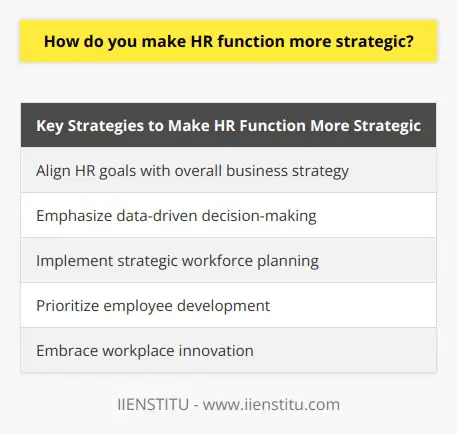
What is the role of human resource in strategy implementation?
Role of Human Resource in Strategy Implementation
Significance of HR in Strategic Planning
Human resource (HR) plays a critical role in strategy implementation by aligning organizational goals with employees' skills and motivations. HR professionals are responsible for identifying the skill sets required to achieve strategic objectives and ensuring that employees possess the necessary competencies.
Recruitment and Selection
One of the main functions of HR is recruitment and selection, which entails identifying, attracting, and hiring talented individuals to fill identified gaps within the organization. An effective recruitment process ensures that the organization's strategic needs are met by hiring employees who match the profiles outlined in the strategic plan.
Training and Skill Development
Another key responsibility of HR is to facilitate employee training and skill development, enabling employees to adapt to changing business objectives or technologies. This function entails designing and implementing training programs that address identified skill gaps, ensuring that employees have the tools they need to contribute to strategic goals.
Performance Management
HR helps with assessing employees' performance, making sure individual goals align with organizational objectives. This process involves establishing clear expectations, monitoring progress, and providing feedback, which enables employees to improve and contribute effectively to strategy implementation.
Employee Involvement and Empowerment
Creating a culture of employee involvement and empowerment is crucial to successful strategy implementation. When employees are actively engaged and invited to participate in strategic decision-making, they are more likely to take ownership of their work and commit to organizational goals. HR plays a vital role in fostering this culture through transparent communication, feedback, and the provision of opportunities for collaboration.
Organizational Change Management
Lastly, HR is responsible for managing organizational change as companies evolve or implement new strategies. This process involves working closely with employees and leaders to ensure a smooth transition, addressing potential challenges or conflicts, and providing resources to support employees through the change.
In conclusion, the role of human resource in strategy implementation is vast and significant. HR professionals are instrumental in aligning employees with strategic objectives, ensuring that the organization is properly equipped to achieve its goals. Through effective recruitment, training, performance management, employee involvement, and change management, HR contributes to the overall success of an organization's strategic plan.

What is the role of HR in strategic management?
Role of HR in Developing and Implementing Strategy
Human Resource (HR) departments play a crucial role in formulating and executing an organization's strategic management activities. Strategic management is vital for an organization's long-term success, focusing on the decisions and actions taken to achieve its mission, vision, and objectives.
Linking HR Activities to Organizational Strategy
HR professionals must ensure their actions align with the overall organizational objectives. By linking each HR activity to the company's strategy, they contribute to enhancing the organization's competitive advantage. This alignment involves responsibilities such as workforce planning, recruitment, talent management, and compensation strategies that directly impact the organization’s bottom line.
Participation in Formulation of Strategy
HR’s role extends beyond supporting existing strategies; they actively participate in the strategy formulation process. HR professionals contribute valuable insights into the available human capital and guide the organization towards the development of goals considering their workforce's strengths and weaknesses. They must also ensure compliance with employment laws and ethical guidelines during strategy formulation.
Facilitating Organizational Change
HR professionals also play a significant role in organizational change management. They prepare and support employees through the transition process, ensuring minimal resistance and negative effects. This includes developing training and development programs, communication strategies, and support systems to enable a smooth transition for the entire organization.
Building an Agile Workforce
One critical aspect of strategic management is the ability to adapt to changing market conditions. HR professionals are responsible for creating an agile workforce that can adapt and respond to new challenges efficiently. This may involve implementing flexible work arrangements, creating responsive teams, and fostering a culture of continuous learning and improvement.
Evaluation and Control
Monitoring progress and evaluating results are essential components of strategic management. HR professionals monitor the effectiveness of implemented strategies to ensure they align with organizational goals. Through regular assessment and feedback, they assist in making necessary adjustments to ensure long-term success.
In conclusion, the role of HR in strategic management is pivotal, as it drives an organization’s success through the development, implementation, and evaluation of strategies. By linking HR activities to strategy, fostering an agile workforce, and actively participating in the strategic management process, HR professionals contribute to and strengthen overall organizational performance.

How can HR professionals effectively prioritize and balance their operational responsibilities with the need for strategic thinking and planning?
Prioritizing Operational Responsibilities
It is essential for HR professionals to strike a balance between operational responsibilities and strategic thinking when managing their daily tasks. One way to prioritize operational duties is to streamline essential processes, such as payroll management, employee grievance handling, and performance appraisals. By automating and optimizing these repetitive tasks, HR professionals can allocate more time to strategic planning.
Setting Goals and Objectives
Another approach to blending operational and strategic responsibilities is to establish clear objectives for HR professionals. These objectives can be set at regular intervals, be it weekly, monthly, or quarterly. By aligning these goals with the organization's strategic vision, HR professionals can stay focused on their strategic contributions while still addressing operational responsibilities.
Measuring Performance
Measuring the effectiveness of HR processes is crucial for prioritizing operational tasks and determining their impact on organizational success. Metrics such as employee engagement levels, employee turnover rates, and average time-to-hire can help HR professionals evaluate their operational efficiency. Assessments with measurable results will inform HR professionals where improvements are needed, allowing them to make strategic adjustments to enhance performance.
Collaborating with Management
To create a supportive environment for strategic thinking, HR professionals should establish strong lines of communication with management. By maintaining open channels to discuss strategic goals and share insights, HR professionals can more effectively align their day-to-day responsibilities with the organization's overall agenda. Collaboration ensures the seamless integration of operational duties and strategic planning.
Continuous Learning and Adaptation
In today's fast-paced business environment, HR professionals must continually adapt to industry changes and shifting organizational priorities. Through acquiring new HR-related knowledge and skills, HR professionals can stay current with best practices and adjust their strategies accordingly. Continuous learning and adaptation will enable them to manage operational responsibilities effectively while contributing to the company's long-term success.
In conclusion, effective prioritization and balancing of operational responsibilities with strategic thinking can be achieved by streamlining tasks, setting clear objectives, measuring performance, collaborating with management, and continuously learning and adapting to changes in the HR field. By following these practices, HR professionals can successfully integrate both aspects of their role, ensuring their department's positive impact on organizational growth and success.
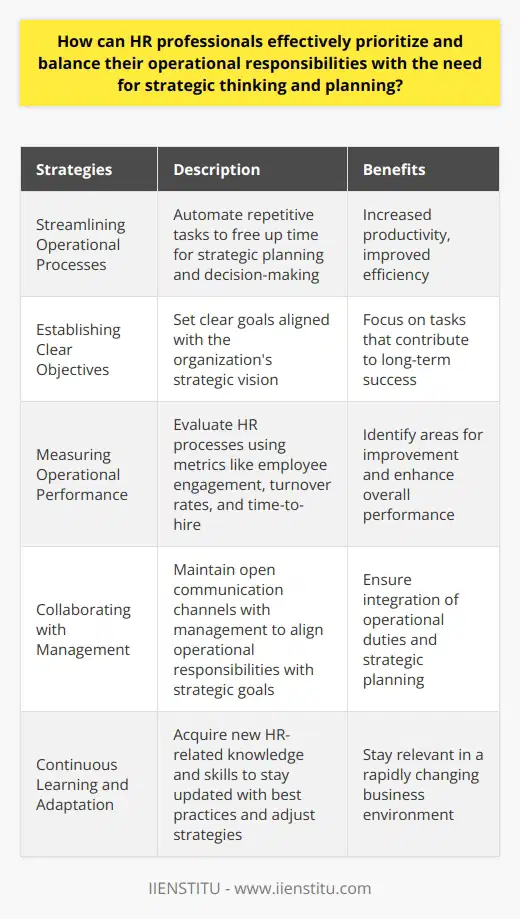
What are the six key elements of strategic human resource management and how do they contribute to an organization's overall success?
**Six Key Elements of Strategic Human Resource Management**
Strategic human resource management (SHRM) aims to align an organization's workforce with its strategic goals for optimal success. There are six key elements of SHRM that contribute to this alignment and overall organizational triumph.
**1. Workforce Planning**
Workforce planning revolves around determining an organization's staffing needs and developing strategies to recruit and retain the right employees. This process ensures the workforce has the necessary skills, experiences, and capabilities to achieve desired outcomes.
**2. Talent Management**
Talent management is about identifying, attracting, and retaining high-performing employees. It includes creating development plans, offering career progression, and providing competitive compensation packages. Effective talent management positively impacts employee motivation and productivity, contributing to organizational success.
**3. Learning and Development**
Learning and development involve nurturing employees' skills, abilities, and knowledge through training programs and educational opportunities. This element promotes professional growth, boosts employee performance, and keeps the organization ahead in terms of innovation and industry trends.
**4. Performance Management**
Performance management focuses on setting clear expectations and assessing employee performance through regular appraisals, feedback, and goal-setting activities. It aims to optimize productivity, ensure employee efforts align with strategic objectives, and recognize top performers, leading to increased motivation and success.
**5. Compensation and Benefits**
Compensation and benefits encompass the design and delivery of competitive remuneration packages to incentivize and reward employees. Fair and attractive compensation policies promote employee satisfaction, performance, and loyalty, positively affecting talent retention and overall success.
**6. Organizational Culture and Change Management**
Lastly, organizational culture and change management deal with fostering a positive, inclusive, and supportive workplace culture. This involves promoting company values and facilitating organizational transformation, resulting in an engaged workforce that can adapt to changes and drive success.
In summary, focusing on the six key elements of strategic human resource management - workforce planning, talent management, learning and development, performance management, compensation and benefits, and organizational culture and change management - enables organizations to synchronize their workforce strategies with business goals. By efficiently implementing these elements, an organization can attract, develop, and retain top talent, cultivate a high-performance culture, and stay competitive, ultimately achieving overall success.
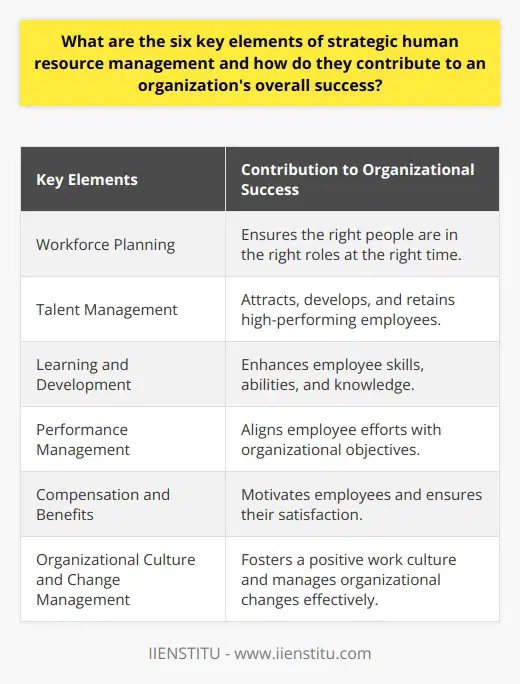
What are the best practices for integrating HR into the strategic planning process of an organization?
Integrating HR in Strategic Planning
To effectively integrate Human Resources (HR) into the strategic planning process of an organization, certain best practices must be adopted. These best practices ensure that HR plays a proactive role in supporting the company's vision and mission, leading to higher levels of productivity and employee engagement.
Aligning HR Goals with Organizational Objectives
Firstly, HR goals must be aligned with organizational objectives. This involves fostering a strong relationship between HR professionals and top management, wherein HR leaders actively participate in strategic planning discussions and decisions. This collaboration is crucial for setting, implementing, and tracking the progress of HR initiatives that contribute to the overall success of the organization.
Involving HR in Business Units
Additionally, HR should be involved in strategic planning across different business units. This requires HR professionals to develop a comprehensive understanding of key operational areas, such as sales, marketing, and finance. With this knowledge, HR can tailor its strategies and programs (e.g., talent acquisition, performance management, etc.) to meet the specific needs of each organizational unit, effectively driving business results.
Leveraging HR Analytics
Another best practice is leveraging HR analytics. Data-driven decision-making is essential for developing evidence-based strategies that address the organization's most pressing human capital challenges. This involves collecting and analyzing relevant HR data to identify trends, gaps, and opportunities for improvement. Such insights enable HR to prioritize initiatives, allocate resources effectively, and design interventions that advance the organization's strategic goals.
Promoting a Performance Culture
Furthermore, HR should promote a performance culture within the organization. This entails establishing clear expectations for employee performance and continually monitoring progress towards these goals. HR can foster a high-performance culture by refining performance management systems, offering regular feedback, and rewarding top performers. These practices encourage employees to commit to the organization's objectives and drive them to contribute actively to the achievement of its strategic goals.
Continuous Learning and Adaptation
Lastly, best practices in integrating HR into strategic planning processes involve continuous learning and adaptation. HR leaders should remain up-to-date with external developments and industry trends to effectively respond to changes in the business environment. This necessitates continuous professional development, collaboration with industry counterparts, and integration of new ideas and best practices into the organization's HR strategies.
In conclusion, adopting these best practices for integrating HR into the strategic planning process of an organization results in better alignment between HR initiatives and organizational goals, increased employee engagement and performance, and improved overall business success.
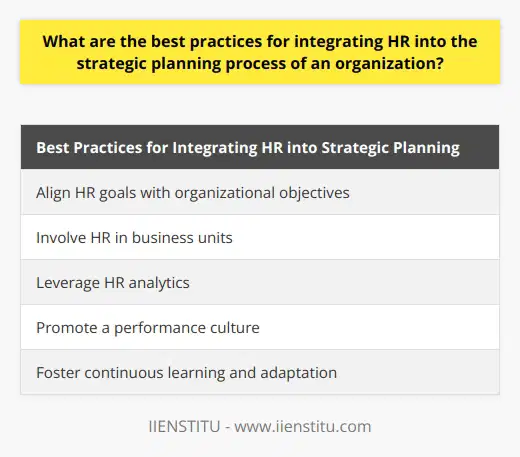
How can HR analytics contribute to more informed decision-making and enhance the strategic value of human resources?
HR Analytics and Informed Decision-Making
Leveraging HR analytics is essential for informed decision-making as it provides comprehensive insights into workforce trends and workforce performance. It enables organizations to make data-driven decisions that optimize talent acquisition, retention, and development, ultimately contributing to the strategic value of human resources.
Data-Driven Solutions for Talent Acquisition
When HR departments harness the power of analytics, they can more effectively identify the best candidates for specific positions by using data-driven metrics. By analyzing job requirements, candidate qualifications, and historical success rates, HR professionals can streamline recruitment processes and ensure the selection of individuals who fit organizational needs.
Optimizing Employee Retention Strategies
HR analytics also serves as a valuable tool in enhancing employee retention strategies, as it helps identify the key factors contributing to attrition. By examining employee engagement, satisfaction, and performance, HR professionals can develop targeted strategies that address these concerns and foster a more conducive work environment, ultimately promoting employee retention and reducing turnover costs.
Enhancing Performance Management and Development
HR analytics has the potential to improve performance management and employee development initiatives. By using data on individual and team performance, HR departments can create customized development programs that capitalize on employee strengths while addressing their areas of improvement. This tailored approach helps create a highly skilled and motivated workforce, leading to organizational success.
Strategic Workforce Planning
Additionally, HR analytics can inform strategic workforce planning by predicting demand for specific skillsets and competencies. It allows HR professionals to anticipate future labor market trends, enabling them to optimize workforce composition proactively, while aligning talent capabilities with business objectives. Thus, analytics can significantly enhance workforce planning and talent management efficiency.
In conclusion, HR analytics can significantly contribute to more informed decision-making by providing valuable insights into recruitment, retention, performance management, and workforce planning. By leveraging these insights, organizations can enhance the strategic value of their human resources while also advancing overall business performance and organizational effectiveness.

How does a comprehensive understanding of organizational culture and values contribute to the formulation of HR strategies and policies?
Organizational Culture and HR Strategies
A comprehensive understanding of organizational culture and values significantly contributes to the formulation of human resource (HR) strategies and policies. It enables HR professionals to align their practices with the organization's goals, fostering better employee engagement and commitment. This connection ultimately leads to improved organizational performance.
Assessing the Cultural Context
Analyzing the cultural context is vital because it reveals intricate details about employee expectations, communication patterns, and preferred leadership styles. By grasping these elements, HR professionals can develop strategies and policies that meet stakeholders' needs. These tailored practices drive positive employee behavior, enhancing overall workplace effectiveness.
Promoting Meaningful Recruitment
When HR strategies are rooted in organizational culture and values, HR professionals can identify candidates that best fit the organization's needs. This alignment ensures that new employees share the organizational values, making them more likely to contribute positively to the team, resulting in better onboarding experiences and reduced turnover rates.
Enhancing Employee Development
Understanding the organizational culture guides the creation of development programs that integrate employees' personal aspirations with the organization's goals. By providing meaningful learning opportunities, HR professionals can boost employee satisfaction, fueling increased motivation and commitment to their roles.
Facilitating Communication and Feedback
A strong grasp of organizational culture and values enables HR professionals to create suitable communication channels and feedback mechanisms. This responsiveness allows employees to share their concerns and offer suggestions for improvement. Open channels of communication bolster transparency and trust between employees, leading to improved organizational performance.
Creating a Supportive Work Environment
HR policies that reflect organizational culture and values lay the groundwork for a supportive work environment, where employees experience a sense of belonging and well-being. A positive work environment bolsters engagement and reduces potential conflicts, enhancing overall productivity and quality of work.
In conclusion, a comprehensive understanding of organizational culture and values is essential in formulating effective HR strategies and policies. This deep understanding ensures alignment with stakeholders' expectations, promotes meaningful recruitment, enhances employee development, facilitates communication and feedback, and creates a supportive work environment. Altogether, these factors contribute to fostering a high-performing organization.

How can HR add strategic value by partnering with line managers to achieve better workforce alignment and performance?
Role of HR in Strategic Partnerships
Human Resource (HR) departments play a vital role in organizational success through their active collaboration with line managers. This partnership ensures better workforce alignment and enhanced overall performance.
Collaborative Approach to Workforce Planning
HR can contribute strategically by working closely with line managers in developing workforce plans that align employees' skills and abilities with the organization's objectives. This collaborative approach can result in improved job satisfaction, reduced turnover, and increased productivity.
Facilitating Effective Communication
HR professionals can foster a culture of open communication between line managers and their teams, facilitating discussions on performance expectations and encouraging feedback. This transparent communication can lead to a better understanding of organizational goals and the development of strategies to achieve them.
Providing Training and Development Opportunities
By collaborating with line managers, HR can identify skill gaps and initiate targeted training and development programs to address them. This focus on continuous learning not only enhances employee performance but also prepares the workforce for upcoming challenges and opportunities.
Performance Management and Employee Engagement
Another critical area where HR can add strategic value is in the implementation of effective performance management systems. By partnering with line managers, HR can help develop and implement systems to set clear performance expectations, track progress, and provide feedback to employees. This collaborative approach can lead to increased employee engagement and improved performance.
Supporting Talent Management Initiatives
HR can work with line managers to effectively identify and manage high-potential employees. Developing a pipeline of talent ensures organizational continuity and fosters innovation as these individuals prepare for leadership positions in the future.
Enabling Change Management
Partnering with line managers, HR can play a vital role in implementing change management initiatives that drive organizational transformation. By offering change management expertise and support, HR can facilitate the smooth adoption of new processes and technologies, while minimizing potential disruptions.
In conclusion, HR can add significant strategic value by partnering with line managers to achieve better workforce alignment and performance. Through collaborative efforts in workforce planning, communication, training, and development, performance management, talent management, and change management, HR professionals can contribute to the overall organizational success while simultaneously ensuring employee growth and satisfaction.

What is the importance of integrating HR functions into the strategic decision-making process, and how can this contribute to organizational performance and competitive advantage?
Significance of HR Integration in Strategic Decision-Making
The integration of Human Resource (HR) functions into the strategic decision-making process plays a crucial role in enhancing organizational performance and achieving a competitive advantage. In today's rapidly evolving business landscape, organizations must respond quickly to changes, necessitating strategic adjustments and adaptability. HR's involvement ensures that the organization's talent pool aligns with strategic goals and enhances overall competitiveness.
Strengthening Organizational Performance
Integrating HR into strategic decisions leads to improved organizational performance by ensuring that human capital is optimized. HR can identify talent gaps, develop training programs, and offer targeted recruitment to acquire skilled employees. The alignment of HR and strategic objectives leads to increased employee engagement, retention, motivation, and productivity, boosting the organization's performance.
Enhancing Competitive Advantage
The involvement of HR in strategic planning contributes to a competitive advantage by developing a workforce that is agile, skilled, and responsive to emerging trends. HR's role in talent management and succession planning ensures a robust pipeline of future leaders, enabling organizations to respond to competitive pressures and seize new opportunities. Moreover, a proactive HR strategy helps organizations foster a positive corporate culture, enhancing their appeal in the labor market, and attracting top talent.
Driving Innovation
In today's knowledge-driven economy, innovation is a vital source of competitive advantage. By integrating HR functions in strategic decisions, organizations can identify skills needed for innovative endeavors, create cross-functional teams, and allocate resources effectively. An organization that invests in its employees' growth and development is better equipped to foster a culture of innovation, leading to new product developments and improvements in existing offerings.
Facilitating Change Management
Organizations must navigate continual changes in the business world, including shifts in consumer preferences, technological advancements, and economic fluctuations. HR plays an essential role in managing change by identifying and addressing employees’ concerns and providing training to facilitate smooth adjustments. When HR functions are integrated into strategic decision-making, they can effectively lead change initiatives and help organizations overcome hurdles associated with transformation.
In conclusion, integrating HR functions into the strategic decision-making process is critical for organizations aiming to achieve high performance, competitive advantage, and continued growth. By aligning human capital with strategic objectives, fostering innovation, and effectively managing change, HR's proactive involvement contributes to organizations' ongoing success.
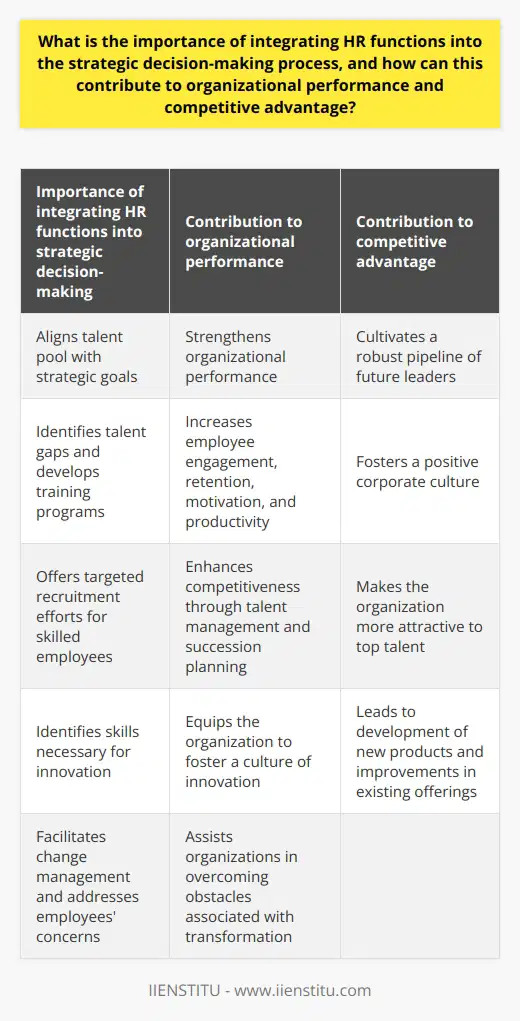
How can strategic management and HR collaborate effectively to enhance organizational culture, employee engagement, and talent development, ultimately creating value for the organization?
Enhancing Organizational Culture
Effective collaboration between strategic management and human resource (HR) departments is critical for fostering a robust organizational culture. Strong organizational culture nurtures growth and boosts workplace productivity, augmenting overall value for organizations. By aligning HR practices with strategic objectives, both entities can work towards a shared vision and direction.
Promoting Employee Engagement
Employee engagement boosts when strategic management and HR work together to create and maintain a supportive work environment. Defining clear expectations and communicating organizational values contribute to engaging employees in the fulfillment of their duties. Consequently, fostering employee commitment and loyalty enhances the overall performance of the organization.
Fostering Talent Development
Talent development is vital for the long-term success of an organization, and a strong partnership between strategic management and HR significantly improves this process. The synergy allows organizations to identify and evaluate potential leaders, facilitate opportunities for growth, and offer personalized training and support. Consequently, these tailored development programs pave the way for future organizational success.
Creating Value for the Organization
In conclusion, the collaboration between strategic management and HR is essential for enhancing organizational culture, employee engagement, and talent development. When both departments coalesce in their efforts, they create a solid foundation for driving organizational success and adding value to the organization. Ultimately, this partnership serves as a crucial driver for sustainable growth and competitive advantage.
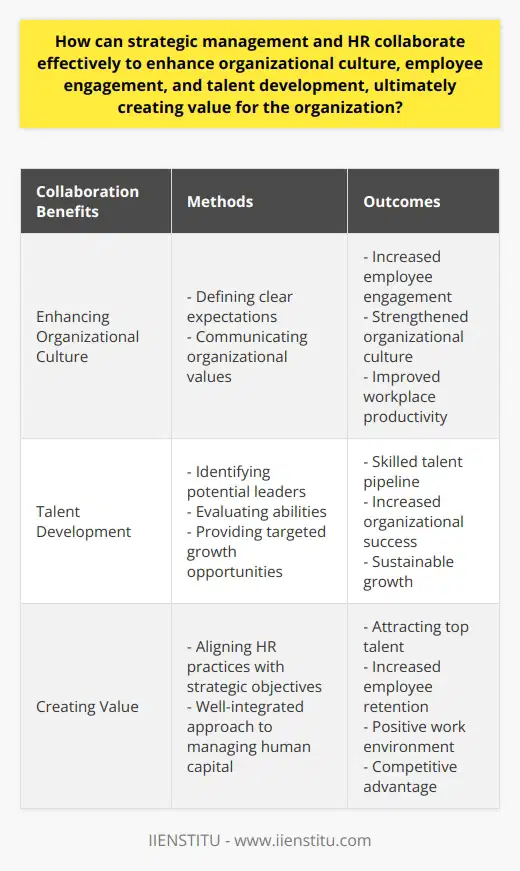
What is the role of HR in fostering innovation and agility within an organization and how can this contribute to sustainable competitive advantage?
Role of HR in Encouraging Innovation
The role of Human Resources (HR) in fostering innovation within an organization is crucial, as it is responsible for creating an environment that encourages and supports the development of new ideas, strategies, and solutions. This can be achieved by implementing various tactics including talent attraction, training and development, and promoting a culture of innovation.
Attracting Innovative Talent
The first step in creating an innovative organization is to attract and retain innovative talent. HR plays a pivotal role in this process by crafting job descriptions, recruitment strategies, and compensation packages that appeal to creative thinkers and problem solvers. By doing so, HR contributes to the overall competitiveness of the organization by ensuring it has access to skilled professionals who can drive the company forward with innovative ideas.
Training and Development for Innovation
Another key aspect of HR's role in fostering innovation is providing employees with the training and professional development opportunities necessary for them to expand and utilize their skill sets in generating novel ideas. Through continuous learning and development programs, HR provides employees with the tools they need to think critically, creatively, and autonomously, which in turn fosters innovation within the company.
Promoting a Culture of Innovation
In addition, HR contributes to the development of a culture that puts innovation at the forefront by creating policies, rituals, and rewards systems that recognize and celebrate employees' innovative achievements. This can involve building innovation labs, providing flexible work arrangements, and offering incentives for employees to initiate or participate in innovative projects. A supportive culture encourages employees to take risks, challenge the status quo, and collaborate with colleagues to develop groundbreaking solutions for the organization.
Sustainable Competitive Advantage through HR's Support for Innovation
By nurturing an innovative and agile workforce, HR contributes to the creation of a sustainable competitive advantage within the organization. This is because having a constant pipeline of innovative ideas and solutions allows the organization to differentiate itself from competitors, target new market segments, and adapt quickly to changes in the business environment. Ultimately, HR's role in fostering innovation within an organization is essential for long-term success and prosperity.
In summary, HR plays a vital part in fostering innovation and agility within an organization by attracting innovative talent, providing ongoing training and development, and creating a supportive culture that drives employees to explore and implement new ideas. These efforts contribute to the development of a sustainable competitive advantage, enabling the organization to thrive in today's competitive business landscape.

How can HR support and enable organizational transformation, particularly in response to technological advancements and changes in markets?
Role of HR in Organizational Transformation
To effectively facilitate organizational transformation, human resource (HR) departments must strategically align workforce development with technological advances and evolving market conditions. This integration necessitates proactive and adaptive HR practices, which include reskilling, talent management, fostering innovation, and managing change.
Reskilling and Upskilling
One crucial HR responsibility is identifying skill gaps in employees and addressing them through targeted training programs. By providing upskilling opportunities and reskilling initiatives, HR can ensure that employees are equipped to adapt to technological advancements and contribute effectively to the organization's success.
Talent Management and Recruitment
HR plays a pivotal role in attracting and retaining top talent, crucial for advancing a company's competitive edge in today's fast-paced markets. Incorporating thorough evaluation and selection processes, HR can identify candidates who possess the necessary skills, values, and mindset to drive transformative initiatives and foster a culture of innovation.
Fostering Innovation
Innovation is paramount to adapting and thriving amidst rapid technological change. HR can encourage a culture of innovation by implementing policies that promote open communication, collaboration, and continuous learning. Furthermore, recognizing and rewarding employees who propose innovative solutions or ideas can facilitate a creative and adaptive workforce.
Managing Change
To effectively manage change, HR must first acknowledge the impact of disruptive technologies and shifting market forces on employees. By establishing transparent communication channels and providing support during times of uncertainty, HR can help employees embrace change and navigate through transitions. In addition, offering resources such as mental health support and stress-reduction programs can further aid employees in adapting to new circumstances and maintaining overall well-being.
In conclusion, HR has a vital role in enabling organizational transformation by creating a workforce prepared to face the challenges and opportunities presented by technological advancements and shifting market trends. By prioritizing reskilling, talent management, innovation, and change management, HR can support and empower organizations in their evolution towards sustainable success.

What are the key methodologies for measuring and evaluating the impact of HR's strategic initiatives on overall organizational performance and success?
Key Methodologies for Measuring HR's Impact
Quantitative Metrics Approach
One of the principal methods for assessing the impact of HR's strategic initiatives is the quantitative metrics approach. This involves collecting and analyzing numerical data related to key performance indicators (KPIs), such as employee turnover, time-to-hire, and performance ratings. By monitoring these KPIs, organizations can track the progress of HR initiatives and determine their influence on overall performance.
Balanced Scorecard
The balanced scorecard is another valuable technique to evaluate HR's impact on organizational success. This framework examines four perspectives: financial, customer, internal process, and learning and growth. By tying HR's strategic objectives to specific measures within these areas, organizations can better understand how their human resource efforts contribute to broader organizational goals.
Return on Investment (ROI) Analysis
Evaluating the return on investment (ROI) of HR initiatives is crucial for demonstrating their significance in organizational success. ROI analysis involves calculating the financial benefits gained from a particular HR initiative and comparing it to the costs incurred in implementing it. This enables organizations to determine the value of their HR efforts and prioritize resources accordingly.
Qualitative Assessments
Apart from numeric evaluations, qualitative assessments play a vital role in measuring HR's influence on organizational performance. They involve gathering anecdotal evidence through interviews, focus groups, and surveys to capture employee perceptions and opinions on HR initiatives. These insights offer valuable context and help identify areas for improvement in HR strategies.
Benchmarking
Lastly, benchmarking is a crucial methodology for assessing the effectiveness of HR's strategic initiatives. This entails comparing an organization's HR metrics with those of other companies or industry standards, facilitating an understanding of the organization's performance relative to competitors or best practices. This analysis guides organizations in making informed decisions about revamping or maintaining their HR initiatives.
In conclusion, a combination of quantitative and qualitative methodologies, including quantitative metrics, balanced scorecard, ROI analysis, qualitative assessments, and benchmarking, is essential to comprehensively evaluating the impact of HR's strategic initiatives on overall organizational performance and success. By continually assessing the effectiveness of their HR practices, organizations can ensure that their human capital investments contribute positively to achieving their strategic objectives.
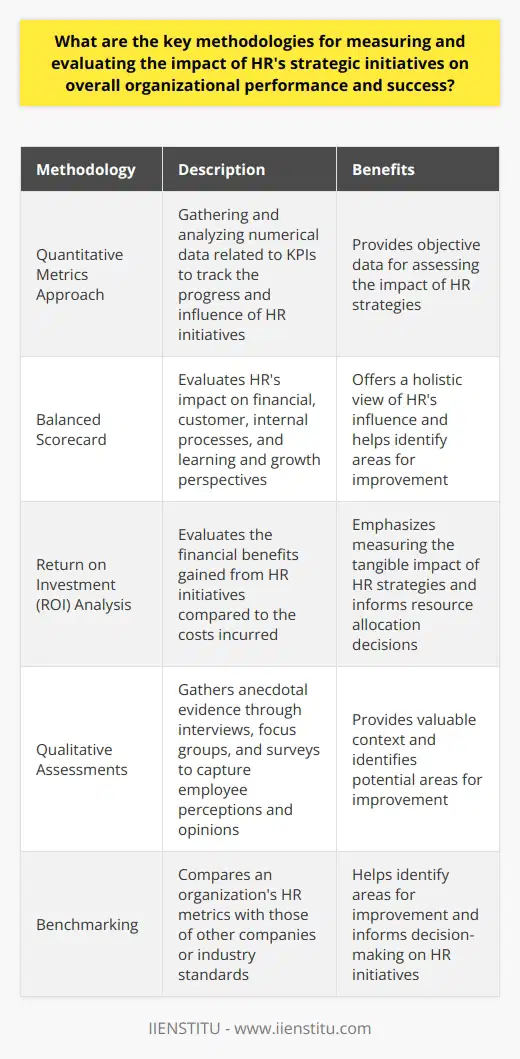
What is the role of HR in fostering innovation and agility within an organization and how can this contribute to sustainable competitive advantage?
Role of HR in Fostering Innovation
The role of Human Resources (HR) in fostering innovation and agility within an organization is crucial as it directly influences the overall productivity and competitiveness of the firm. HR's primary responsibility is to establish a work environment that encourages creativity, nurtures talent, and promotes continuous learning among employees. This objective is achieved through various strategies, such as offering suitable rewards and recognition, providing opportunities for skill development, and conducting regular performance evaluations.
Contribution to Sustainable Competitive Advantage
The HR department can contribute to a sustainable competitive advantage by implementing practices that attract, nurture, and retain top talent. By designing innovative recruitment strategies, HR can identify and attract individuals with the expertise, knowledge, and skills required for the organization's success. HR can also foster a culture of continuous learning and development, ensuring that the workforce remains skilled, adaptable, and agile in response to changing market dynamics.
Employee Engagement and Collaboration
HR plays a vital role in promoting employee engagement and collaboration, as engaged employees are more likely to contribute to the development of innovative ideas, products, and services. Creating an environment that values open communication, knowledge sharing, and idea generation encourages employees to work together and contribute to the organization's agility and innovation capabilities.
Risk-taking and Experimentation
To cultivate an innovative and agile workforce, HR should encourage risk-taking and experimentation among employees. This can be done by fostering a culture that embraces dynamic thinking and is open to new and novel approaches. Employees should be encouraged to challenge conventional wisdom, explore innovative solutions, and embrace failures as learning opportunities that can lead to future success.
Organizational Structure and Agility
Another vital aspect of the HR's role in innovation and agility is the optimization of organizational structure. HR professionals must ensure that the organization's structure and processes are flexible and adaptive, allowing employees to respond quickly to changing market conditions and capitalize on opportunities as they emerge. This might include promoting flat organizational structures with minimal bureaucracy, facilitating cross-functional collaboration, and implementing agile methodologies across the organization.
In conclusion, the role of HR in fostering innovation and agility within an organization is multifaceted and crucial for achieving a sustainable competitive advantage. By focusing on talent management, employee engagement, risk-taking, and an adaptive organizational structure, HR can significantly impact the firm's innovation capabilities and responsiveness to market dynamics.

How can strategic management and HR collaborate effectively to enhance organizational culture, employee engagement, and talent development, ultimately creating value for the organization?
Collaborative Approach to Organizational Culture Enhancement
An effective collaboration between strategic management and human resource (HR) can greatly enhance organizational culture, employee engagement, and talent development in an organization. To achieve this, both departments need to share a common vision and align their goals with the organization's objectives. They must work together to communicate the company's values, mission, and culture to current and prospective employees.
Leveraging HR Expertise in Employee Engagement
HR plays a vital role in shaping employee engagement initiatives to increase productivity, satisfaction, and retention. Strategic management can capitalize on HR's expertise in employee engagement by involving HR professionals in crafting engagement programs and ensuring that their implementation aligns with the company's goals. This collaborative effort will help drive employee engagement and contribute to achieving the organization's objectives.
Creating a Talent Development Pathway
A strong partnership between strategic management and HR is essential for developing talent within an organization. Strategic management can guide HR in identifying the core competencies and skills required for current and future success. In turn, HR can design and implement training and development programs tailored to enhance these competencies among the employees. This collaborative approach to talent development will serve to create a more skilled workforce and generate long-term value for the organization.
Monitoring and Evaluating Impact on Organizational Performance
Continuous monitoring and evaluation are crucial to ensure that the collaboration between strategic management and HR produces the desired outcomes. The two departments should establish clear performance metrics to measure the impact of their joint efforts on organizational culture, employee engagement, and talent development. Regular reviews of these metrics will help identify areas for improvement and refine the collaborative strategies to create more value for the organization.
In conclusion, a strong collaboration between strategic management and HR is essential for enhancing organizational culture, improving employee engagement, and fostering talent development. A shared vision, leveraging the expertise of both departments, and continuous monitoring and evaluation of the impact on organizational performance are the hallmarks of effective collaboration. This aligned approach will result in creating lasting value for the organization and its stakeholders.

How can HR support and enable organizational transformation, particularly in response to technological advancements and changes in markets?
Role of HR in Technological Advancements
Human Resource (HR) departments play a crucial role in enabling organizational transformation by aligning talent strategy with changing market needs and technological advancements. To identify gaps in workforce skills, HR should conduct regular skill assessments and implement upskilling initiatives for employees. This can range from designing in-house training programs to collaborating with external educational institutions for specialized courses.
Adopting Agile Practices in HR
HR can also support transformation by adopting agile practices in talent management and employee engagement strategies. Agile HR practices involve fostering a culture of continuous learning, breaking down functional silos, and proactively addressing employee concerns. This ensures rapid response to changing market scenarios and facilitates a smoother organizational transition. HR leaders should also leverage data analytics to identify trends, predict attrition, and identify skill gaps, enabling them to make data-driven decisions about workforce upskilling.
Empowering Digital Workforce
As organizations adopt advanced technologies, HR must ensure that employees are fluent in the tools and software necessary to excel in a digital workplace. HR can execute digital literacy training programs tailored to employees or different departments, equipping them with the skills necessary for seamless digital collaboration. Additionally, HR should work closely with other departments to identify workflow bottlenecks related to technology, developing strategies to bridge gaps between employees' skills and technological requirements.
Creating a Culture of Collaboration
Cultivating a culture of collaboration and continuous improvement is essential for organizations undergoing digital transformation. HR can lead this effort by promoting cross-functional teams, creating an environment that encourages open communication, and recognizing and rewarding employees who drive innovation. Developing leadership programs that prioritize adaptive management styles and nurturing interpersonal skills will empower leaders to support their teams through the challenges of transformation.
In conclusion, the Human Resource department plays a critical role in facilitating organizational transformation, with activities ranging from upskilling workforce to cultivating a highly collaborative work environment. HR should stay attuned to the impact of technological advancements and take a proactive approach in enabling employees to stay competitive in a dynamic market landscape. By being at the forefront of change, HR can ensure that organizations are better equipped to thrive amid constant market shifts and technological developments.

What is the role of HR in fostering innovation and agility within an organization, and how can this contribute to sustainable competitive advantage?
Role of HR in Fostering Innovation
The role of Human Resources (HR) in fostering innovation and agility within an organization is crucial, as it involves managing the most valuable asset - the workforce. HR professionals can actively contribute to creating an innovative and agile culture by developing strategies that identify, attract, and retain creative talent and promote a continuous learning environment.
Talent Acquisition and Retention
To maintain a sustainable competitive advantage, organizations need a workforce ready to tackle new challenges and adapt to change. HR plays a significant role in sourcing candidates with diverse skills and backgrounds, as well as fostering an inclusive work environment that encourages creativity and collaboration. Moreover, HR professionals must develop initiatives that facilitate employee retention, such as designing competitive compensation packages, providing skill development opportunities, and recognizing employees' efforts.
Continuous Learning Environment
Instilling a culture of continuous learning within an organization helps to encourage innovation and agility while keeping employees up-to-date with industry trends and technological advances. HR professionals can develop and implement training programs, workshops, and mentorship opportunities, as well as promote cross-functional collaboration and knowledge sharing. This ultimately leads to a motivated and highly skilled workforce capable of driving the organization towards achieving its goals.
Agile Organization Structure
To foster agility, HR has the responsibility to promote an organization structure that facilitates adaptability, flexibility, and rapid decision-making processes. This involves designing and implementing team structures, communication channels, and performance assessment systems that encourage responsiveness, collaboration, and employee empowerment. An agile organization is better equipped to navigate market volatility and emerging opportunities, thus establishing a sustainable competitive advantage.
Conclusion
In summary, the role of HR in fostering innovation and agility within an organization is instrumental in driving an organization's sustainable competitive advantage. HR professionals contribute to this by focusing on attracting and retaining diverse talent, cultivating a continuous learning environment, and promoting an agile organization structure. Ultimately, these efforts result in a highly skilled, adaptable, and motivated workforce capable of navigating the complexities of today's dynamic business landscape.

How do the roles of HR in talent acquisition, development, and retention align with an organization's strategic objectives and support its long-term success?
**Talent Acquisition's Strategic Alignment**
The role of HR in talent acquisition aligns with an organization's strategic objectives by ensuring they have the right mix of skills within the workforce. This involves determining hiring needs based on long-term objectives, selecting candidates who possess the required competencies, and offering competitive compensation packages to attract top talent. As a result, they build a strong workforce that is competent in delivering the services and products essential to achieving organizational goals.
**Developing Human Capital for Success**
When it comes to talent development, HR plays a crucial part in ensuring the continuous growth and learning of employees in alignment with the organization's needs. This is achieved through proper identification of skill gaps, designing relevant training and development programs, as well as supporting employees in their personal professional growth. As employee skills improve, they contribute to the organization's overall effectiveness and competitive advantage in the market, ultimately leading to long-term success.
**Retention Strategies Supporting Organizational Goals**
Retention of top talent is a critical aspect of HR’s role, as excessive employee attrition imposes financial costs and negatively impacts productivity. HR designs and implements retention strategies that align with the organization's strategic objectives by offering competitive benefits, fostering a positive work culture, and providing opportunities for career growth. By retaining high-performing employees, organizations maintain their levels of expertise and institutional knowledge, which significantly contribute to long-term success.
In summary, human resource departments play an essential role in an organization’s strategic success through talent acquisition, development, and retention efforts. By creating a strong workforce with the right skills and minimizing employee turnover, organisations are better equipped to achieve their long-term goals. Thus, HR's actions in acquiring, nurturing, and retaining talent have a tremendous impact on organizations' overall growth and prosperity.

How can HR leverage technology and automation to streamline processes, improve efficiency, and create strategic value for the organization?
Enhancing Efficiency through HR Technology
One method of leveraging technology to enhance efficiency in the human resources (HR) department is the adoption of automation tools. Automation streamlines routine processes such as payroll management, attendance tracking, and employee onboarding. By removing manual procedures, HR staff can focus on more strategic initiatives that align with the organization's goals.
Data-Driven Decision Making
Utilizing HR software solutions also allows for easier access to data analysis and reporting. These tools can help analyze trends in employee performance, turnover, and engagement, providing valuable insights for decision-making. Consequently, HR personnel can develop targeted strategies to address workforce challenges, enabling more informed decisions to positively impact the organization's direction.
Improving Talent Acquisition
Furthermore, HR technology can be utilized to improve the talent acquisition process. Applicant tracking systems (ATS) streamline the recruitment process, automate candidate screening, and improve communication between candidates and recruiters. This not only increases the efficiency of the hiring process but also helps attract top talent to the organization, ensuring that the company remains competitive in its industry.
Enhancing Employee Development
In addition to streamlining processes, HR technology can also play a key role in employee development. Learning management systems (LMS) allow organizations to offer virtual training and development programs, making it more convenient for employees to enhance their skills. This eases the HR department's burden of organizing and monitoring in-person training, while simultaneously contributing to the organization's long-term success by fostering a culture of continuous learning.
Promoting Employee Engagement
Finally, leveraging HR technology can also promote employee engagement. By deploying digital platforms that allow employees to connect, collaborate, and share ideas, HR can create a cohesive work environment that promotes productivity. Additionally, offering digital performance management tools that enable continuous feedback and recognition can improve employee satisfaction and retention rates.
In conclusion, technology and automation can greatly enhance the efficiency and effectiveness of HR processes, fostering the creation of strategic value for the organization. Through the implementation of HR technology tools, organizations can streamline processes, utilize data-driven decision-making, improve talent acquisition, enhance employee development, and promote engagement, ultimately contributing to the overall success of the company.
